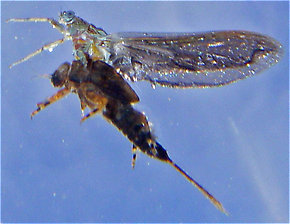Blog & Latest Updates
Fly Fishing Articles
Insects by Common Name


Mayfly Genus Ephemerella (Hendricksons, Sulphurs, PMDs)
Taxonomic Navigation -?-
Kingdom
Animalia (Animals)
» Phylum
Arthropoda (Arthropods)
» Class
Insecta (Insects)
» Order
Ephemeroptera (Mayflies)
» Genus Ephemerella (Hendricksons, Sulphurs, PMDs)
11 species aren't included.
Common Name
| Match | Common Name |
| Hendricksons, Sulphurs, PMDs |
This is page 8 of specimens of Ephemerella. Visit the main Ephemerella page for:
- The behavior and habitat of Ephemerella.
- 37 underwater pictures of Ephemerella.
Pictures of 158 Mayfly Specimens in the Genus Ephemerella:
Ephemerella aurivillii Mayfly Nymph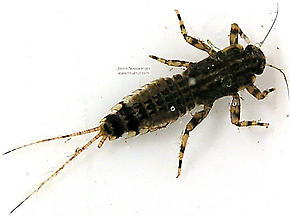 View 4 Pictures
View 4 Pictures
 View 4 Pictures
View 4 PicturesCollected February 5, 2004 from unknown in Wisconsin
Added to Troutnut.com by Troutnut on January 25, 2006
Added to Troutnut.com by Troutnut on January 25, 2006
Ephemerella dorothea infrequens (Pale Morning Dun) Mayfly Nymph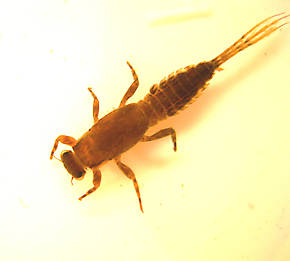 View 2 PicturesHabitat: Shallow riffle over cobble; approx. 1 ft. deep
View 2 PicturesHabitat: Shallow riffle over cobble; approx. 1 ft. deep
Size: 8.5 mm. Mature specimens have been captured as large as 10.5 mm.
Emergence schedule: Variable - starting as early as mid March and lasting as late as early June, depending on the year. Usual duration is at least several weeks or more.
Dun Association: Body is elusive pale creamy yellow w/ orange highlights, cream legs and tails, and dun wings
Specimen status in photo: Preserved
Collection method: Kick net
Comments: Extremely common in samples taken from this location. It's color in life was very close to as depicted in the photo; except for the gradual darkening of the abdominal segments as they progress posteriorly, which has been accentuated somewhat by the effects of preservation. Adult association is based upon capture of this taxon at various stages of emergence including: darkened wingcases, split thoraxic notums, and partially ecloded or ''stillborn (Stillborn: In fly fishing, a stillborn insect is one which got stuck in its nymphal or pupal shuck during emergence and floats helplessly on the surface instead of flying away. It is a specific class of cripple, although it is sometimes used interchangeably with that term.)'' specimens.
Entoman
 View 2 PicturesHabitat: Shallow riffle over cobble; approx. 1 ft. deep
View 2 PicturesHabitat: Shallow riffle over cobble; approx. 1 ft. deepSize: 8.5 mm. Mature specimens have been captured as large as 10.5 mm.
Emergence schedule: Variable - starting as early as mid March and lasting as late as early June, depending on the year. Usual duration is at least several weeks or more.
Dun Association: Body is elusive pale creamy yellow w/ orange highlights, cream legs and tails, and dun wings
Specimen status in photo: Preserved
Collection method: Kick net
Comments: Extremely common in samples taken from this location. It's color in life was very close to as depicted in the photo; except for the gradual darkening of the abdominal segments as they progress posteriorly, which has been accentuated somewhat by the effects of preservation. Adult association is based upon capture of this taxon at various stages of emergence including: darkened wingcases, split thoraxic notums, and partially ecloded or ''stillborn (Stillborn: In fly fishing, a stillborn insect is one which got stuck in its nymphal or pupal shuck during emergence and floats helplessly on the surface instead of flying away. It is a specific class of cripple, although it is sometimes used interchangeably with that term.)'' specimens.
Entoman
Collected March 21, 2011 from the Lower Yuba River in California
Added to Troutnut.com by Entoman on November 1, 2011
Added to Troutnut.com by Entoman on November 1, 2011
Ephemerella subvaria (Hendrickson) Mayfly Nymph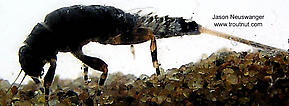 View 4 PicturesHere's one of the darkest E. subvaria nymphs I've seen.
View 4 PicturesHere's one of the darkest E. subvaria nymphs I've seen.
 View 4 PicturesHere's one of the darkest E. subvaria nymphs I've seen.
View 4 PicturesHere's one of the darkest E. subvaria nymphs I've seen.Collected February 7, 2004 from unknown in Wisconsin
Added to Troutnut.com by Troutnut on January 25, 2006
Added to Troutnut.com by Troutnut on January 25, 2006
Ephemerella invaria (Sulphur Dun) Mayfly Nymph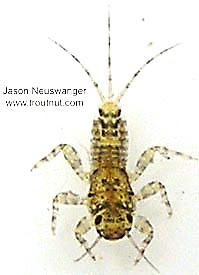 View 4 PicturesI looked at this small Ephemerella nymph very carefully under a microscope. It as no abdominal tubercles (
View 4 PicturesI looked at this small Ephemerella nymph very carefully under a microscope. It as no abdominal tubercles (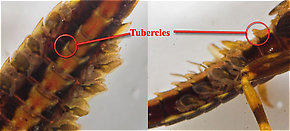 Tubercle: Various peculiar little bumps or projections on an insect. Their character is important for the identification of many kinds of insects, such as the nymphs of Ephemerellidae mayflies.) and 1-banded tibiae (
Tubercle: Various peculiar little bumps or projections on an insect. Their character is important for the identification of many kinds of insects, such as the nymphs of Ephemerellidae mayflies.) and 1-banded tibiae (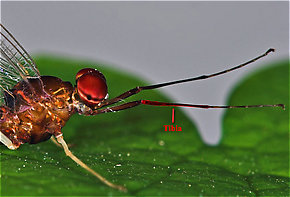 Tibia: A middle segments in the leg of an insect, located between the femur and the tarsus.). I think just a very early instar (Instar: Many invertebrates molt through dozens of progressively larger and better-developed stages as they grow. Each of these stages is known as an instar. Hard-bodied nymphs typically molt through more instars than soft-bodied larvae.) invaria nymph.
Tibia: A middle segments in the leg of an insect, located between the femur and the tarsus.). I think just a very early instar (Instar: Many invertebrates molt through dozens of progressively larger and better-developed stages as they grow. Each of these stages is known as an instar. Hard-bodied nymphs typically molt through more instars than soft-bodied larvae.) invaria nymph.
 View 4 PicturesI looked at this small Ephemerella nymph very carefully under a microscope. It as no abdominal tubercles (
View 4 PicturesI looked at this small Ephemerella nymph very carefully under a microscope. It as no abdominal tubercles (
A few (not all) of the abdominal tubercles on this Ephemerella needhami nymph are circled. They are especially large in this species.

The tibia of this Isonychia bicolor mayfly spinner is highlighted in red.
Collected February 7, 2004 from unknown in Wisconsin
Added to Troutnut.com by Troutnut on January 25, 2006
Added to Troutnut.com by Troutnut on January 25, 2006
Male Ephemerella dorothea infrequens (Pale Morning Dun) Mayfly Spinner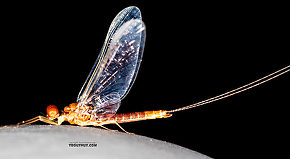 View 6 PicturesThis spinner was collected in proximity to this dun and this other dun, so one of them is likely the same species. Note for ID purposes that this one is missing one of its cerci (Cercus: The left and right "tails" of an insect are known as the cerci or caudal cerci. The middle tail of a three-tailed insect is not.).
View 6 PicturesThis spinner was collected in proximity to this dun and this other dun, so one of them is likely the same species. Note for ID purposes that this one is missing one of its cerci (Cercus: The left and right "tails" of an insect are known as the cerci or caudal cerci. The middle tail of a three-tailed insect is not.).
 View 6 PicturesThis spinner was collected in proximity to this dun and this other dun, so one of them is likely the same species. Note for ID purposes that this one is missing one of its cerci (Cercus: The left and right "tails" of an insect are known as the cerci or caudal cerci. The middle tail of a three-tailed insect is not.).
View 6 PicturesThis spinner was collected in proximity to this dun and this other dun, so one of them is likely the same species. Note for ID purposes that this one is missing one of its cerci (Cercus: The left and right "tails" of an insect are known as the cerci or caudal cerci. The middle tail of a three-tailed insect is not.).Collected July 1, 2019 from the Madison River in Montana
Added to Troutnut.com by Troutnut on July 18, 2019
Added to Troutnut.com by Troutnut on July 18, 2019
Ephemerella (Hendricksons, Sulphurs, PMDs) Mayfly Nymph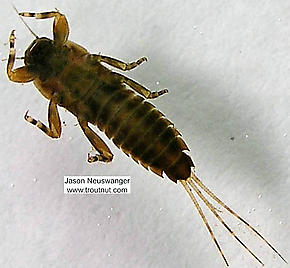 View 3 PicturesMorphologically this one looks a lot like subvaria but the color is really different.
View 3 PicturesMorphologically this one looks a lot like subvaria but the color is really different.
 View 3 PicturesMorphologically this one looks a lot like subvaria but the color is really different.
View 3 PicturesMorphologically this one looks a lot like subvaria but the color is really different.Collected January 13, 2004 from the Namekagon River in Wisconsin
Added to Troutnut.com by Troutnut on January 25, 2006
Added to Troutnut.com by Troutnut on January 25, 2006
Ephemerella subvaria (Hendrickson) Mayfly Nymph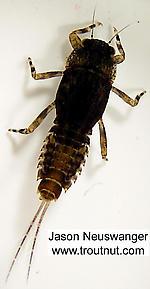 View 3 PicturesThis is one of the nymphs I collected doing something very, very strange on March 17th 2004. In the middle of the day, around 2 pm, in the water right around my feet I watched lots of Ephemerella nymphs clumsily swimming up all the way to the surface and then just kind of drifting and wiggling around in the water column. None hatched. They seemed to do it more intensely when the sun was out. It wasn't the time of day for the normal invertebrate drift phenomenon, and as far as I know invertebrate drift doesn't involve this kind of clear effort to swim all the way to the surface. I didn't need a net to catch them, I just reached down into the water and grabbed them with my fingers just below the surface.
View 3 PicturesThis is one of the nymphs I collected doing something very, very strange on March 17th 2004. In the middle of the day, around 2 pm, in the water right around my feet I watched lots of Ephemerella nymphs clumsily swimming up all the way to the surface and then just kind of drifting and wiggling around in the water column. None hatched. They seemed to do it more intensely when the sun was out. It wasn't the time of day for the normal invertebrate drift phenomenon, and as far as I know invertebrate drift doesn't involve this kind of clear effort to swim all the way to the surface. I didn't need a net to catch them, I just reached down into the water and grabbed them with my fingers just below the surface.
The prominent abdominal tubercles ( Tubercle: Various peculiar little bumps or projections on an insect. Their character is important for the identification of many kinds of insects, such as the nymphs of Ephemerellidae mayflies.) aren't quite black, though, and the general color is a dark brown, though I saw nymphs with all Hendrickson color stages behaving strangely.
Tubercle: Various peculiar little bumps or projections on an insect. Their character is important for the identification of many kinds of insects, such as the nymphs of Ephemerellidae mayflies.) aren't quite black, though, and the general color is a dark brown, though I saw nymphs with all Hendrickson color stages behaving strangely.
 View 3 PicturesThis is one of the nymphs I collected doing something very, very strange on March 17th 2004. In the middle of the day, around 2 pm, in the water right around my feet I watched lots of Ephemerella nymphs clumsily swimming up all the way to the surface and then just kind of drifting and wiggling around in the water column. None hatched. They seemed to do it more intensely when the sun was out. It wasn't the time of day for the normal invertebrate drift phenomenon, and as far as I know invertebrate drift doesn't involve this kind of clear effort to swim all the way to the surface. I didn't need a net to catch them, I just reached down into the water and grabbed them with my fingers just below the surface.
View 3 PicturesThis is one of the nymphs I collected doing something very, very strange on March 17th 2004. In the middle of the day, around 2 pm, in the water right around my feet I watched lots of Ephemerella nymphs clumsily swimming up all the way to the surface and then just kind of drifting and wiggling around in the water column. None hatched. They seemed to do it more intensely when the sun was out. It wasn't the time of day for the normal invertebrate drift phenomenon, and as far as I know invertebrate drift doesn't involve this kind of clear effort to swim all the way to the surface. I didn't need a net to catch them, I just reached down into the water and grabbed them with my fingers just below the surface.The prominent abdominal tubercles (

A few (not all) of the abdominal tubercles on this Ephemerella needhami nymph are circled. They are especially large in this species.
Collected March 17, 2004 from the Namekagon River in Wisconsin
Added to Troutnut.com by Troutnut on January 25, 2006
Added to Troutnut.com by Troutnut on January 25, 2006
Ephemerella invaria (Sulphur Dun) Mayfly Nymph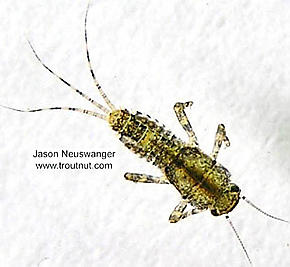 View 3 Pictures
View 3 Pictures
 View 3 Pictures
View 3 PicturesCollected January 13, 2004 from the Namekagon River in Wisconsin
Added to Troutnut.com by Troutnut on January 25, 2006
Added to Troutnut.com by Troutnut on January 25, 2006
Ephemerella invaria (Sulphur Dun) Mayfly Nymph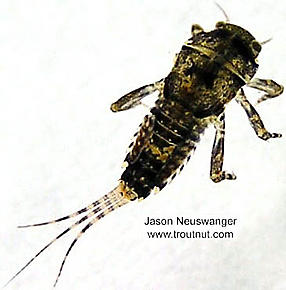 View 3 Pictures
View 3 Pictures
 View 3 Pictures
View 3 PicturesCollected January 13, 2004 from the Namekagon River in Wisconsin
Added to Troutnut.com by Troutnut on January 25, 2006
Added to Troutnut.com by Troutnut on January 25, 2006
Ephemerella invaria (Sulphur Dun) Mayfly Nymph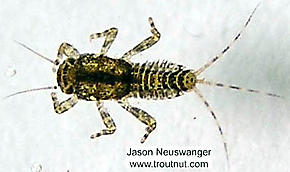 View 3 Pictures
View 3 Pictures
 View 3 Pictures
View 3 PicturesCollected January 13, 2004 from the Namekagon River in Wisconsin
Added to Troutnut.com by Troutnut on January 25, 2006
Added to Troutnut.com by Troutnut on January 25, 2006
Top 10 Fly Hatches
Top Gift Shop Designs
Eat mayflies.
Top Insect Specimens
Miscellaneous Sites
Troutnut.com is copyright © 2004-2024 Jason
Neuswanger (email Jason). See my FAQ for information about use of my images.
 privacy policy
privacy policy

